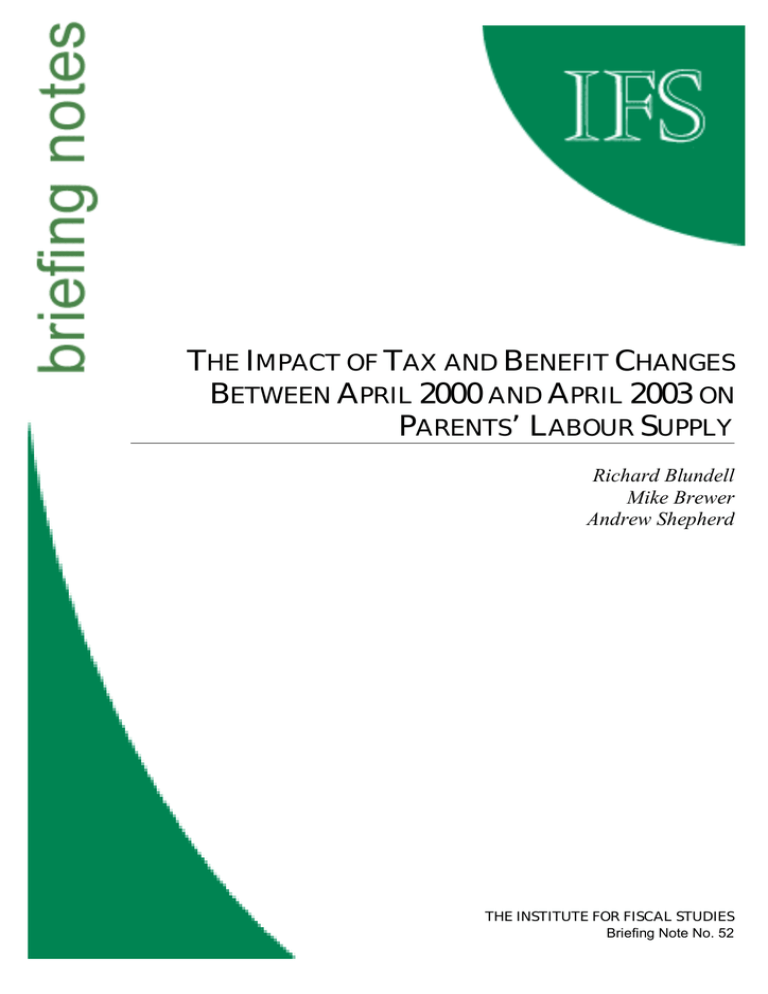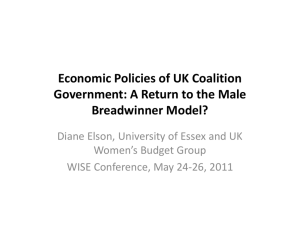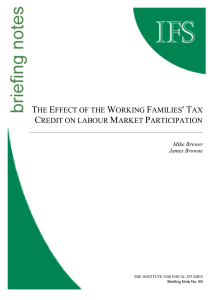T I B
advertisement

THE IMPACT OF TAX AND BENEFIT CHANGES BETWEEN APRIL 2000 AND APRIL 2003 ON PARENTS’ LABOUR SUPPLY Richard Blundell Mike Brewer Andrew Shepherd THE INSTITUTE FOR FISCAL STUDIES Briefing Note No. 52 The Impact of Tax and Benefit Changes Between April 2000 and April 2003 on Parents’ Labour Supply Richard Blundell, Mike Brewer and Andrew Shephard* Institute for Fiscal Studies 1. Introduction In 2003, tax credits for families saw their second substantial reform since Labour came to power in 1997. Two new tax credits were introduced in April 2003 – the child tax credit and the working tax credit, collectively referred to as the new tax credits – and two were abolished – the working families’ tax credit (WFTC) and the children’s tax credit. The government claimed that the new tax credits would provide ‘an additional £2.7 billion to support families with children, tackle poverty and make work pay’ (HM Treasury Press Release, 17 April 2002). The child tax credit effectively merged several parts of the existing tax and benefit system that support families with children. Separately, the working tax credit supports adults with or without children in low-paid work, as well as providing subsidies for certain childcare expenditure for some working parents. This Briefing Note provides the first published estimates of the labour market impact of the new tax credits, and the tax and benefit reforms that preceded them, on families with children. Specifically, this note examines all personal tax and benefit reforms introduced between April 2000 and April 2003. We use a structural model of labour supply to examine how these changes affect both the participation rate (the proportion of parents who would like to work at a given hourly wage) and the average weekly hours of work. We examine how the impact varies between lone mothers and adults in couples with children, and how it varies with both the number of children and the age of the youngest child in the family. The outline of the note is as follows. In Section 2, we describe the tax and benefit reforms in which we are interested and then, in Section 3, we briefly * This work was part-funded by the Bank of England and part-funded by the ESRC Research Centre for the Microeconomic Analysis of Public Policy at IFS. It uses a model of labour supply whose development was funded by the Inland Revenue. None of these institutions bears any responsibility for the views stated here, however. The authors are very grateful for helpful discussions and comments from Ian Bond, Mike Joyce, Howard Reed and Jonathan Thomas, and all errors and omissions remain those of the authors alone. Data from the Family Resources Survey was provided by the Department for Work and Pensions, and is also available from the UK Data Archive. An earlier version of this note was entitled “The Impact of the New Tax Credits on Parents’ Labour Supply”. © Institute for Fiscal Studies, 2004 describe the methodology that we use. Section 4 presents our results. We should point out two limitations. First, this note does not examine the impact of the new working tax credit on people without children: our analysis is limited to families with children. Second, as described later, the analysis uses a structural model of labour supply, and work is in progress to update this model using data up to March 2003; it is possible that these updates will lead to revised estimates of the impact of these reforms. 2. Description of Reforms This note analyses the labour market impact of the set of personal tax and benefit reforms between April 2000 and April 2003.1 It is a natural extension of the analysis in Brewer et al. (2003), which analysed the reforms between April 1999 and April 2000 (work to be published in 2005 will analyse the impact of reforms between April 1999 and April 2002, a period that has a large overlap with that analysed here). Our analysis directly compares the tax and benefit systems in April 2000 and April 2003, which means that the systems in force in between are irrelevant. But it is interesting to consider what changes took place in between, as many of them were designed to phase in the extra cost implied by the new tax credits. It is also important that other changes to taxes and benefits, not specific to families with children, were made over the same period. The main reforms and their likely effect on the financial incentive to work are as follows: • There were increases in income support / jobseeker’s allowance payments for families where all the adults who are working work less than 16 hours per week between March 2001 and October 2002. These directly reduced the financial gain from working 16 or more hours. • There were increases in the generosity of WFTC between June 2000 and June 2002 over and above the initial increase in generosity implied by the move from family credit to WFTC in October 1999 and April 2000. • The married couple’s allowance was abolished in April 2000 and the children’s tax credit was introduced in April 2001. The latter provided a reduction of up to £530 per year in the income tax bill of adults in families with children paying income tax, but the value of the credit was tapered away for families with one or more higher-rate income-tax-payers. • In April 2003, these effects were combined and consolidated into an entirely new tax credit system, with the child tax credit replacing the 1 Brewer, Clark and Myck (2001) explore the rationale behind the tax credits. Brewer (2003) provides an overview of the finalised system. 2 children’s tax credit, the per-child elements of WFTC, the childcare support element of WFTC and the per-child elements of the income support and jobseeker’s allowance systems. Similarly, the working tax credit replaced the adult component of WFTC, and there was a new working tax credit for low-income families without children. Over and above the effects described above, the reform led to increases in state support for most low-income families with children and produced some winners and losers amongst highincome families with children.2 • In April 2003, employee, self-employed and employer National Insurance contributions (NICs) were all increased by 1 percentage point. This rise had no upper income limit, and thus extended beyond the National Insurance upper earnings limits. We model only the employee components of the NICs rise here. • In April 2003, the income tax personal allowance and the primary and secondary thresholds for NICs were frozen rather than being uprated by inflation. This implied a cut in real terms. 3. Methodology No publicly available data-set yet exists that will support an ex-post evaluation of the new tax credits. However, it is possible to estimate the likely labour market impact of the new tax credits (and the tax and benefit changes that preceded them) for lone mothers and couples with children using data from before their introduction. In this Briefing Note, we make use of a structural model of labour supply that has been used to evaluate WFTC. For details of the model, see Brewer et al. (2003). In brief, the structural model involves using a tax and benefit micro-simulation model to calculate an individual’s net income at a number of different choices of weekly hours of work, given an hourly wage. We are then able to make inferences about the individual’s preferences by assuming that they actually chose the number of hours that best suits them. Using the estimates of their preferences, we can then predict how individuals will respond to changes in the tax and benefit system that alter the trade-off between hours of work and income after taxes and benefits. The labour supply model is estimated using data from the Family Resources Survey from 1995–96 to 2001–02. Separate models are estimated for lone mothers and for couples with children (lone fathers are omitted). It should be noted that work is in progress at IFS to update this model using data up to 2 See Brewer (2003) or appendix B of Chote, Emmerson and Simpson (2003). 3 March 2003; it is possible that these updates will lead to revised estimates of the impact of these reforms. Because we did not want to predict how levels of take-up of the new tax credits compared with take-up of WFTC, we have assumed full take-up in both scenarios. 4. Results All the results are shown in Table 1. Below, we discuss our results separately for lone mothers and parents in couples. Lone Mothers Lone parents have been a key target group of the government’s reforms. In the upper panel of Table 1, we summarise our results for lone mothers. The table shows the estimated change in the labour market participation rate and the estimated changes in average weekly hours of work among all lone mothers, regardless of whether or not they are working (unconditional hours), and for workers only (conditional hours).3 We predict that the tax and benefit reforms between April 2000 and April 2003 increased the labour supply of lone mothers by 3.38 percentage points. This corresponds to around 50,000 extra lone mothers in work. New workers are split roughly equally between full-time and part-time work (not shown in Table 1). This increase in work effort is partially offset by reductions in the labour supply of those who were originally working: we estimate that the reforms have reduced the average hours worked by working lone mothers by 0.23 hours. Table 1 also shows how the effect of the reforms between April 2000 and April 2003 varies by both the number of children and the age of the youngest child. A very clear pattern emerges: the positive effect on labour market participation is greater the older is the youngest child in the family and the fewer the number of dependent children, and the negative effect on hours worked is greater the younger is the youngest child in the family and the greater the number of dependent children. Overall, the effect of increased participation offsets the reduction in hours worked among workers only (conditional hours) so that average hours across all lone mothers, regardless of whether or not they are working, increase. The table demonstrates that the reforms were more successful in increasing unconditional hours for lone mothers with small families and older children than for lone mothers with larger families and young children. 3 The transition matrices that were used to derive these participation changes are available upon request. 4 The reforms have clearly had an important impact on the work incentives and likely labour market behaviour of lone mothers. To put these changes in context, Brewer et al. (2003) estimated, using the same methodology as in this Briefing Note, that the reforms between April 1999 and April 2000 increased the labour supply of lone mothers by an almost identical magnitude of 3.37 5 6 Couples with children Change in participation rate (% points) Men, overall Men, partner working Men, partner not working Women, overall Women, partner working Women, partner not working Change in proportion of: Workless households One-earner households Two-earner households Average predicted change in hours Men, overall (unconditional hours) Men, overall (conditional hours) Women, overall (unconditional hours) Women, overall (conditional hours) Lone mothers Change in participation rate (% points) Average predicted change in hours Unconditional Conditional 1.48 0.61 2.32 0.44 –0.00 5.21 –1.27 0.62 0.65 0.38 –0.25 –0.29 –0.80 –0.86 1.15 –0.29 0.17 –0.23 –0.57 –0.71 0.19 –0.71 0.85 –0.23 0.92 0.22 2.34 –0.35 –0.75 4.42 1.27 0–2 3.38 All Table 1. The impact of reforms between April 2000 and April 2003 0.21 –0.25 –0.72 –0.90 –0.89 1.48 –0.59 1.07 0.41 2.02 –0.77 –1.15 4.79 0.59 –0.64 3.12 0.18 –0.24 –0.68 –0.74 –0.82 1.23 –0.41 0.97 0.38 2.54 –0.56 –0.96 4.09 1.05 –0.17 4.21 Age of youngest child 3–4 5–10 –0.08 –0.19 –0.64 –0.54 –0.49 1.43 –0.94 0.23 –0.25 2.42 –0.68 –1.04 3.77 1.30 –0.01 4.25 11+ 0.25 –0.19 –0.42 –0.54 –0.92 0.87 0.05 1.03 0.29 3.16 –0.06 –0.45 4.40 1.21 –0.17 4.17 1 0.12 –0.25 –0.66 –0.77 –0.81 1.32 –0.50 0.84 0.16 2.26 –0.53 –0.93 4.87 0.67 –0.40 3.05 Number of children 2 0.13 –0.27 –0.64 –1.07 –0.88 1.30 –0.42 0.92 0.22 1.62 –0.46 –0.90 3.69 0.26 –0.80 1.96 3+ percentage points. However, these earlier reforms encouraged lone mothers in work to increase their work effort, compared with the slight decrease we find from the more recent reforms. Couples with Children We present our results for couples with children in the lower panel of Table 1. Our model predicts that the tax and benefit reforms between April 2000 and April 2003 will raise the participation rate of fathers in couples by 0.92 percentage points, corresponding to an additional 34,000 fathers in work. For mothers in couples, we estimate a strong positive effect of 4.42 percentage points if their partner is not working. However, the relatively small size of this group means it is dominated by the reduction in labour supply that we estimate for mothers with working partners. The overall effect on mothers in couples is estimated to be negative: –0.35 percentage points, or 13,000 fewer individuals. As was the case with lone mothers, we predict that the new tax credits encourage parents in work, on average, to reduce their hours of work. In contrast, Brewer et al. (2003) found that WFTC induced a small reduction in labour market participation for both mothers and fathers in couples. However, almost no impacts were found on hours of work among working parents. An alternative way of summarising our results for couples follows Gregg and Wadsworth (1996) in dividing couples into no-earner couples (or workless households), one-earner couples and two-earner couples. We predict that the reforms favour the formation of single-earner couples (a 1.15 percentage point increase), largely at the expense of workless households, but also by a small reduction in the proportion of dual-earner couples. In other words, the changes in labour market participation arise because some workless couples move to being single-earner couples and some two-earner couples move to being singleearner couples. We have also examined how the labour supply responses vary by the number of children and the age of the youngest child. We find a very different pattern from that for lone mothers. We find a more positive labour participation response the fewer the number of dependent children, but the response is also more positive the younger is the youngest child. 5. Conclusion This Briefing Note has provided estimates of the labour market impact of the new tax credits and the reforms that preceded them on parents, using data from the Family Resources Survey and a structural model of labour supply. We predict that these tax and benefit changes, dominated by the new tax credits, will increase lone mothers’ participation by 3.38 percentage points, reduce that of mothers in couples by 0.35 percentage points and increase that of 7 fathers in couples by 0.92 percentage points. The reforms also encourage couples to become single-earner families. Unlike WFTC (where the effect was approximately neutral), the new tax credits are predicted to encourage parents in work, on average, to reduce their desired hours of work. References Brewer, M. (2003), The New Tax Credits, Briefing Note 35, London: Institute for Fiscal Studies (www.ifs.org.uk/taxben/bn35.pdf). Brewer, M., Clark, T. and Myck, M. (2001), Credit Where It’s Due? An Assessment of the New Tax Credits, Commentary 86, London: Institute for Fiscal Studies (www.ifs.org.uk/taxben/taxcred.shtml). Brewer, M., Duncan, A., Shephard, A. and Suárez, M. J. (2003), ‘Did working families’ tax credit work? Analysing the impact of in-work support on labour supply and programme participation’, Inland Revenue Working Paper 2 (www.inlandrevenue.gov.uk/research/ifs-laboursupply.pdf). Chote, R., Emmerson, C. and Simpson, H. (eds), The IFS Green Budget: January 2003, Commentary 92, London: Institute for Fiscal Studies (www.ifs.org.uk/gb2003/gb2003.pdf). Gregg, P. and Wadsworth, J. (1996), ‘More work in fewer households?’, in J. Hills (ed.), New Inequalities: The Changing Distribution of Income and Wealth in the United Kingdom, Cambridge: Cambridge University Press. 8





